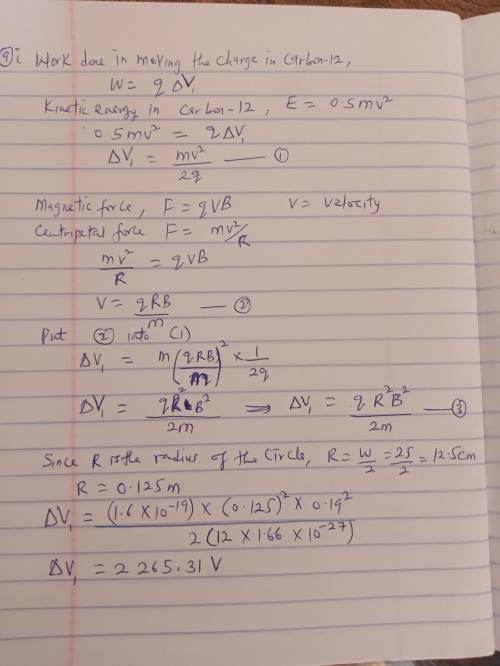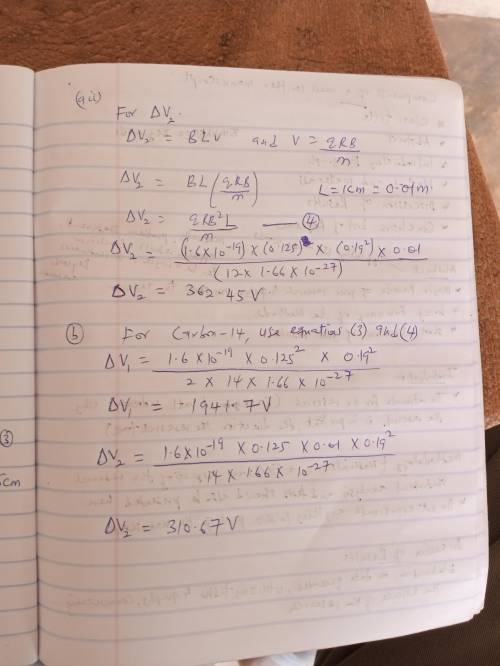
Physics, 05.05.2020 03:43 kaylaaguilar6538
Mass spectrometer A mass spectrometer is a tool used to determine accurately the mass of individual ionized atoms or molecules, or to separate atoms or molecules that have similar but slightly different masses. For example, you can deduce the age of a small sample of cloth from an ancient tomb, by using a mass spectrometer to determine the relative abundances of carbon-14 (whose nucleus contains 6 protons and 8 neutrons) and carbon-12 (the most common isotope, whose nucleus contains 6 protons and 6 neutrons). In organic material, the ratio of 14C to 12C depends on how old the material is, which is the basis for "carbon-14 dating." 14C is continually produced in the upper atmosphere by nuclear reactions caused by "cosmic rays" (high-energy charged particles from outer space, mainly protons), and 14C is radioactive with a half-life of 5700 years. When a cotton plant is growing, some of the CO2 it extracts from the air to build tissue contains 14C which has diffused down from the upper atmosphere. But after the cotton has been harvested there is no further intake of 14C from the air, and the cosmic rays that create 14C in the upper atmosphere can't penetrate the atmosphere and reach the cloth. So the amount of 14C in cotton cloth continually decreases with time, while the amount of non-radioactive 12C remains constant.
Carbon from the sample is ionized in the ion source at the left. The resulting singly ionized 12C+ and 14C+ ions have negligibly small initial velocities (and can be considered to be at rest). They are accelerated through the potential difference ΔV1. They then enter a region where the magnetic field has a fixed magnitude B = 0.19 T. The ions pass through electric deflection plates that are 1 cm apart and have a potential difference ΔV2 that is adjusted so that the electric deflection and the magnetic deflection cancel each other for a particular isotope: one isotope goes straight through, and the other isotope is deflected and misses the entrance to the next section of the spectrometer. The distance from the entrance to the fixed ion detector is a distance of w = 25 cm. There are controls that let you vary the accelerating potential ΔV1 and the deflection potential ΔV2 in order that only 12C+ or 14C+ ions go all the way through the system and reach the detector. You count each kind of ion for fixed times and thus determine the relative abundances. The various deflections ensure that you count only the desired type of ion for a particular setting of the two voltages.
Determine the appropriate numerical values of ΔV1 and ΔV2 for 12C. Carry out your intermediate calculations algebraically, so that you can use the algebraic results in the next part.
ΔV1 = 4 V
ΔV2 = 5 V
Determine the appropriate numerical values of ΔV1 and ΔV2 for 14C.
ΔV1 = 6 V
ΔV2 = 7 V

Answers: 2


Other questions on the subject: Physics

Physics, 22.06.2019 03:50, am2garcia5
A30 kg weight lies on top of a massless piston of area a = 0.01 m2 the exterior air is at a (constant) p =1 atm and t = 27 c. the interior gas is 0.4 moles of (ideal) n2 and it has initial temperature 27.00 degrees c. 1. what is the initial pressure in the interior? a. 29.4 kpa b. 130.7 kpa c. 101.3 kpa the next three questions concern what happens when an amount of heat q is slowly added to the interior, raising the piston by 1 mm and raising the interior temperature to 27.40 c
Answers: 3

Physics, 22.06.2019 11:20, leandrogarin37p2g5ds
Suppose a diode consists of a cylindrical cathode with a radius of 6.200×10^−2 cm , mounted coaxially within a cylindrical anode with a radius of 0.5580 cm . the potential difference between the anode and cathode is 260 v . an electron leaves the surface of the cathode with zero initial speed (v initial=0). find its speed vfinal when it strikes the anode.
Answers: 1

Physics, 22.06.2019 11:20, loganfreeman04
If the radius of curvature of the cornea is 0.75 cm when the eye is focusing on an object 36.0 cm from the cornea vertex and the indexes of refraction are as described before, what is the distance from the cornea vertex to the retina? express your answer to two significant
Answers: 3

Physics, 22.06.2019 15:00, banna01man
Greg drew a diagram to compare two of the fundamental forces. which labels belong in the areas marked x, y and z? gravitational force electromagnetic force x. attractive y repulsive z: infinite range x: infinite range y attractive z. repulsive x. always attractive y: infinite range z: attractive or repulsive x. attractive or repulsive y infinite range z: always attractive
Answers: 2
You know the right answer?
Mass spectrometer A mass spectrometer is a tool used to determine accurately the mass of individual...
Questions in other subjects:







Mathematics, 15.04.2020 01:30



Chemistry, 15.04.2020 01:30





